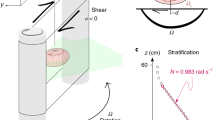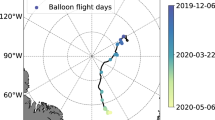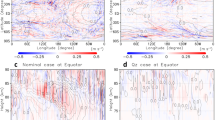Abstract
Fine laminar structures in the atmosphere have been described previously1,2,3,4,5,6,7,8,9, but their characterization has been limited. The modern global coverage of aircraft flights offers an opportunity to provide such a characterization, and examine the ubiquity of such structures, in space and time. Research aircraft measuring vertical profiles of atmospheric chemical constituents frequently discern quasi-horizontal atmospheric layers with mean thicknesses of the order of 1 km and mean altitudes between 5 and 7 km (refs 10,11,12). These layers can be characterized and categorized by various combinations of ozone, water vapour, carbon monoxide and methane deviations from background profiles. Five commercial aircraft have been recently equipped to measure water vapour and ozone concentrations, and automatically collect vertical profile information on landing and take-off (refs 13,14,15). Here we synthesize measurements from both research and commercial flights and demonstrate the ubiquity in space and time of four layer types (as categorized by their chemical signatures). Up to one-fifth of the lowest 12 km of the atmosphere is occupied by such layers. We suggest that this universality reflects basic characteristics of the atmosphere hitherto unexplored, with potential implications for present understanding of a wide variety of dynamic and chemical atmospheric processes.
This is a preview of subscription content, access via your institution
Access options
Subscribe to this journal
Receive 51 print issues and online access
$199.00 per year
only $3.90 per issue
Buy this article
- Purchase on Springer Link
- Instant access to full article PDF
Prices may be subject to local taxes which are calculated during checkout


Similar content being viewed by others
References
Danielsen, E. F. The laminar structure of the atmosphere and its relation to the concept of a tropopause. Arch. Meteorol. Geophys. Bioklimatol. 11, 293–332 (1959).
Danielsen, E. F. Stratospheric–tropospheric exchange based on ozone and potential vorticity. J. Atmos. Sci. 25, 502–518 (1968).
Corby, G. A. Apreliminary study of atmospheric waves using radiosonde data. Q. J. R. Meteorol. Soc. 83, 49–60 (1957).
Reid, S. J. An observational study of lee waves using radiosonde data. Tellus 24, 593–596 (1982).
Shutts, G. J., Kitchen, M. & Hoare, P. H. Alarge amplitude gravity wave in the lower stratosphere detected by radiosonde. Q. J. R. Meteorol. Soc. 114, 579–594 (1988).
Bethan, S., Vaughan, G. & Reid, S. J. Acomparison of ozone and thermal tropopause heights and the impact of tropopause definition on quantifying the ozone content of the troposphere. Q. J. R. Meteorol. Soc. 122, 929–944 (1996).
Sawyer, J. S. Quasi-periodic wind variations with height in the lower stratosphere. Q. J. R. Meteorol. Soc. 87, 24–33 (1961).
Newell, R. E., Mahoney, J. R. & Lenhard, R. . W. J Apilot study of small-scale wind variations in the stratosphere and mesosphere. Q. J. R. Meteorol. Soc. 92, 41–54 (1966).
Gage, K. S. & Balsley, B. B. MST radar studies of wind and turbulence in the middle atmosphere. J. Atmos. Terr. Phys. 46, 739–753 (1984).
Newell, R. E. et al. Vertical fine-scale atmospheric structure measured from NASA DC-8 during PEM-West A. J. Geophys. Res. 101, 1943–1960 (1996).
Wu, Z. -X. et al. Atmospheric layers measured from the NASA DC-8 during PEM-West B and comparison with PEM-West A. J. Geophys. Res. 102, 28353–28365 (1997).
Stoller, P. et al. Measurements of atmospheric layers from the NASA DC-8 and P-3B aircraft during PEM-Tropics A. J. Geophys. Res.(in the press).
Thouret, V., Marenco, A., Logan, J. A., Nédélec, P. & Grouhel, C. Comparisons of ozone measurements from the MOZAIC airborne program and the ozone sounding network at eight locations. J. Geophys. Res. 103, 25695–25720 (1998).
Marenco, A. et al. Measurement of ozone and water vapour by Airbus in-service aircraft: The MOZAIC airborne program, an overview. J. Geophys. Res. 103, 25631–25642 (1998).
Helten, M. et al. Calibration and performance of automatic compact instrumentation for the measurement of relative humidity from passenger aircraft. J. Geophys. Res. 103, 25643–25652 (1998).
Hoell, J. M. et al. Pacific exploratory mission-west A (PEM-West A): September–October 1991. J. Geophys. Res. 101, 1641–1653 (1996).
Hoell, J. M. et al. The Pacific exploratory mission-west phase B: February–March, 1994. J. Geophys. Res. 102, 28223–28239 (1997).
Hoell, J. M. et al. The Pacific exploratory mission in the tropical Pacific: PEM-Tropics A, August–September, 1996. J. Geophys. Res.(in the press).
Hoffman, R. N. A Computer Program which Calculates Radiative Fluxes and Heating Rates in Model Atmospheres(Sci. Rep. No. 4, Dept Meteorol. Phys. Oceanogr., MIT, Cambridge, MA, (1981).
Brasseur, GP., Müller, J. F. & Granier, C. Atmospheric impact of NOx emissions by subsonic aircraft: A three dimensional model study. J. Geophys. Res. 101, 1423–1428 (1996).
Edouard, S., Legras, B., Lefèvre, F. & Eymard, R. The effect of small-scale inhomogeneities on ozone depletion in the Arctic. Nature 384, 444–447 (1996).
Newell, R. E., Zhu, Y., Browell, E. V., Read, W. G. & Waters, J. W. Walker circulation and tropical upper tropospheric water vapor. J. Geophys. Res. 101, 1961–1974 (1996).
Acknowledgements
We thank our PEM and MOZAIC colleagues for access to their data, Air France, Lufthansa, Austrian Airlines and Sabena for carrying the MOZAIC equipment, and the NASA GTE, ACMAP, and GSFC Research Assistantship programs for their support.
Author information
Authors and Affiliations
Corresponding author
Rights and permissions
About this article
Cite this article
Newell, R., Thouret, V., Cho, J. et al. Ubiquity of quasi-horizontal layers in the troposphere. Nature 398, 316–319 (1999). https://doi.org/10.1038/18642
Received:
Accepted:
Issue Date:
DOI: https://doi.org/10.1038/18642
This article is cited by
-
A pervasive role for biomass burning in tropical high ozone/low water structures
Nature Communications (2016)
-
Comparison of statistical clustering techniques for the classification of modelled atmospheric trajectories
Theoretical and Applied Climatology (2010)
-
Clean air slots amid atmospheric pollution
Nature (2002)
Comments
By submitting a comment you agree to abide by our Terms and Community Guidelines. If you find something abusive or that does not comply with our terms or guidelines please flag it as inappropriate.



